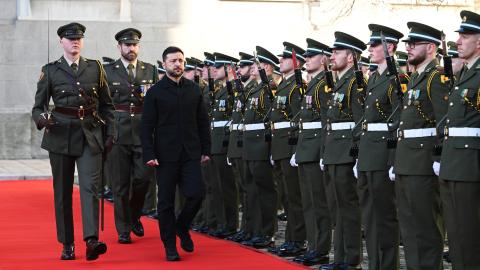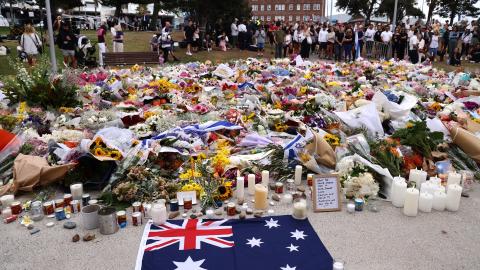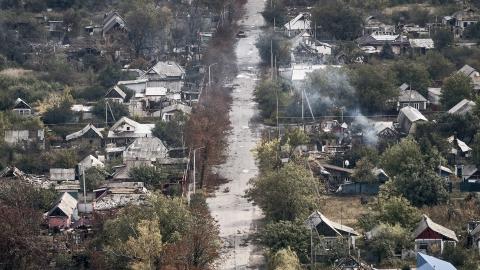Executive Summary
- Battlefield assessment: The Russian military increased its pressure on Ukraine with an overwhelming tempo of tactical engagements near Pokrovsk and Kupiansk.
- Russia’s drone warfare campaign: As winter approaches, Russia launched systematic drone salvos that targeted Ukraine’s energy grid.
- Tomahawks reenter the aid discussion: Kyiv is lobbying the United States to provide it with Tomahawk cruise missiles, a potentially game-changing long-range strike capability.
- What to watch for: (1) Russia’s increased operational tempo, (2) strikes on energy infrastructure, and (3) the situation in Pokrovsk and Kupiansk.
1. Battlefield Assessment
Attritional drone warfare shaped this week’s operational picture. With winter approaching, Russia is systematically targeting Ukraine’s energy grid with large, precision-targeted drone salvos. Meanwhile, the Ukrainian military continued its deep strike campaign against Russian energy infrastructure.
Russia’s massive drone manufacturing capacity, bolstered by its cooperation with Iran, has allowed it to hit Ukraine relentlessly. Last week, Chernihiv, Sumy, Poltava, and their adjacent regions suffered blackouts that complicated hospital operations. Ukrainian grid operators continued to work on rapid repair cycles. But frequent drone attacks have stressed the country’s air defenses and hindered its ability to produce spare parts for its grid.
Shahed-Baseline Drone Strikes on Ukraine by Month
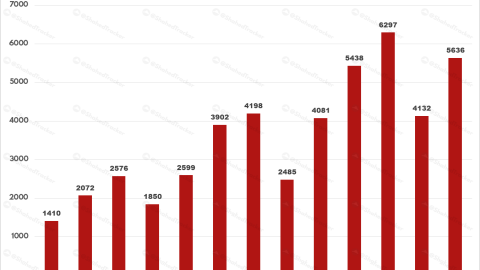
Chart via Shahed Tracker (@ShahedTracker) on X.
Russian drone strikes have intensified across the entire battle space. In all, Moscow launched more than 5,600 Shahed drones in September 2025. Open-source intelligence suggests that Russia has established 15 principal Shahed launch positions within its borders and in occupied Crimea.
Meanwhile, Kyiv’s deep strike campaign hit the Feodosia and Hvardiiske oil logistics facilities in occupied Crimea. Imagery intelligence indicates that two strikes this month destroyed at least 11 fuel tanks at Feodosia. Russian channels also confirmed heavy Ukrainian drone warfare activity in the area, though Russian forces intercepted many of Kyiv’s projectiles.
Damage to Feodosia Oil Depot
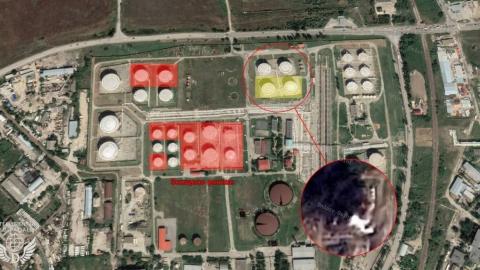
Image via Ukrinform.
On the ground, the Pokrovsk sector remained the most active front. Ukraine’s General Staff recorded between 168 and 202 daily tactical combat engagements in its most recent 24-hour reporting cycles, with over one-third of these concentrated around Pokrovsk. In line with recent combat trends near that city, Russian formations continued to grind forward against reinforced Ukrainian defensive positions in an effort to capture the operational center of gravity of the eastern front.
In Dobropillia, the Russian military attempted a relatively large-scale armored assault, which the Ukrainian Azov Brigade repelled. The situation in Kupiansk deteriorated, with Kyiv issuing evacuation orders for civilians in the wake of persistent Russian offensive action.
2. Tomahawks for Ukraine: A Long Shot, but a Potential Game-Changer
In Washington on October 17, Ukrainian President Volodymyr Zelenskyy confirmed that President Donald Trump did not rule out supplying Ukraine with Tomahawk long-range cruise missiles. Zelenskyy emphasized that Ukrainian forces, which rely primarily on domestically produced drones, are vulnerable to Russian missile and drone warfare. Ukraine’s leader characterized the possible addition of Tomahawks to Ukraine’s arsenal as a critical force multiplier that could threaten key Russian targets.
Transferring Tomahawks to Ukraine would mark a major inflection point for Western support of Ukraine. The Tomahawk is one of the most effective missiles in the arsenals of North Atlantic Treaty Organization (NATO) nations. The Kremlin threatened retaliation if the United States supplied Ukraine with the High Mobility Artillery Rocket System (HIMARS), the Army Tactical Missile System (ATACMS), and other weapons. But these threats have been largely empty. This record suggests that Russian signaling, while designed to deter and intimidate, does not guarantee a proportional kinetic response.
The missile boasts a range of 1,500 miles and could dramatically improve Ukraine’s long-range strike deterrent if supplied in sufficient numbers. Experts suggest that the Tomahawk’s strategic appeal lies less in its raw explosive yield and more in its precision. It has digital-scene mapping capabilities and high-end guidance enabled by the Global Positioning System (GPS). The missile’s low radar cross-section also enhances its survivability.
Kyiv views the Tomahawk as a necessary tool to impose sufficient strategic costs on Russian logistics networks, air defenses, and energy infrastructure. Providing Ukraine with Tomahawks would force the Russian military to reallocate some of its layered air defense systems, which are currently combat deployed near the front lines, to rear areas. Such a move would inevitably free up airspace for the Ukrainian Air Force’s growing fleet of F-16 aircraft and Western-supplied ground-attack smart munitions.
To some extent, the US defense industry’s ability to manufacture Tomahawks dictates Ukraine’s likelihood of receiving them, as the missile would be crucial to US forces in a confrontation in the Indo-Pacific. Current estimates suggest the US can produce between 50 and 70 of the projectiles per year. Moreover, the US defense industry’s efforts to modernize the missile’s maritime strike variant have stressed production. Finally, because Western systems rely heavily on secure datalinks, satellite guidance, and centralized authorization protocols, Kyiv’s independent targeting capability would be limited without sustained and prompt technical support from allies.
Nonetheless, the provision of Tomahawks to Ukraine would be a major political and military development.
3. What to Monitor in the Coming Weeks
As Moscow presses its manpower advantage and Kyiv continues to strike Russia’s energy infrastructure, three trends bear monitoring in the weeks to come:
- The number of tactical engagements in Ukraine: Rarely do more than 200 tactical engagements occur across the battle space on any given day. It remains to be seen whether the war’s increased operational tempo in recent months is a fleeting push or an indicator of sustainably heightened Russian military activity.
- Russian salvos against the Ukrainian energy grid: For now, the Russian military is only striking key components of Ukraine’s energy grid, while relying on consecutive drone salvos to attrit Ukraine’s defenses. But as winter approaches, Russian strikes could limit Ukraine’s energy supplies and affect its overall military strategy. Ukraine’s interceptor stockpiles—and the overall shape of the nation’s air defense network—will bear watching in the coming weeks.
- The situation in Pokrovsk and Kupiansk: Pokrovsk has long been the strategic center of gravity in Ukraine’s eastern sector, while Kupiansk has emerged as a flashpoint in the north. Russian offensives have subjected both cities to highly attritional pressure. Any weakness in Ukrainian defensive combat operations around the two beleaguered areas could prove catastrophic for Kyiv.




